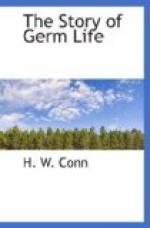There are, however, some species which cause mankind much trouble by interfering in one way or another with the normal processes of life. These pathogenic bacteria, or disease germs, do not all act alike, but bring about injury to man in a number of different ways. We may recognise two different classes among them, which, however, we shall see are connected by intermediate types. These two classes are, first, the pathogenic bacteria, which are not strictly parasitic but live free in Nature; and, second, those which live as true parasites in the bodies of man or other animals. To understand the real relation of these two classes, we must first notice the method by which bacteria in general produce disease.
Method by which bacteria produce disease.
Since it was first clearly recognised that certain species of bacteria have the power of producing disease, the question as to how they do so has ever been a prominent one Even if they do grow in the body, why should their presence give rise to the symptoms characterizing disease? Various answers to this question have been given in the past It has been suggested that in their growth they consume the food of the body and thus exhaust it, that they produce an oxidation of the body tissues, or that they produce a reduction of these tissues, or that they mechanically interfere with the circulation None of these suggestions have proved of much value Another view was early advanced, and has stood the test of time. This claim is that the bacteria while growing in the body produce poisons, and these poisons then have a direct action on the body We have already noticed that bacteria during their growth in any medium produce a large number of biproducts of decomposition. We noticed also that among these biproducts there are some which have a poisonous nature; so poisonous are they that when inoculated into the body of an animal they may produce poisoning and death. We have only to suppose that the pathogenic bacteria, when growing as parasites in man, produce such poisons, and we have at once an explanation of the method by which they give rise to disease.
This explanation of germ disease is more than simple theory. It has been in many cases clearly demonstrated. It has been found that the bacteria which cause diphtheria, tetanus, typhoid, tuberculosis, and many other diseases, produce, even when growing in common culture media, poisons which are of a very violent nature. These poisons when inoculated into the bodies of animals give rise to much the same symptoms as the bacteria do themselves when growing as parasites in the animals. The chief difference in the results from inoculating an animal with the poison and with the living bacteria is in the rapidity of the action. When the poison is injected the poisoning symptoms are almost immediately seen, but when the living bacteria are inoculated the effect is only seen after several days or longer,




